Lane Memorial Celebrating 100 Years
By William H. Teschek
Atlantic News & Advertiser, Tuesday, March 31, 1981
[The following article is courtesy of the Atlantic News]
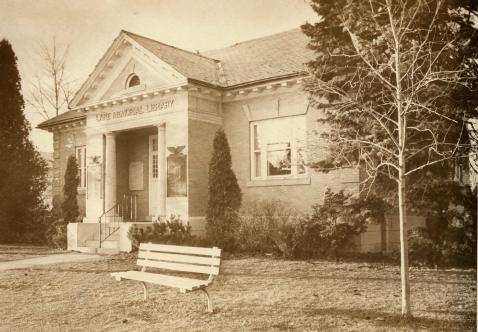
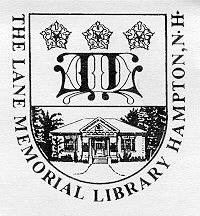
The history of libraries in Hampton begins in the year 1804, with the formation of a private social library.
At an organizational meeting hold on January 2 of that year, Rev. William Pidgin, Rev. Jesse Appleton, and Dr. Ebenezer Lawrence were chosen as a committee "to form regulations and purchase books for the library." Joshua Lane was elected treasurer, Col. Jonathan Garland, clerk, and Dr. Lawrence, librarian.
The society circulated a subscription paper, placing the terms of membership at two dollars per share, an annual tax of fifty cents, and in all affairs of the society, one vote for each share owned. In 1807, the society was incorporated under the name of “The Proprietors of the Hampton Library.”
An annual meeting was held each year on the first Monday of January, and at any other time delegated by the committee on nine days notice. The by-laws were revised in 1812 by eliminating the office of clerk and in 1817 by eliminating the office of treasurer.
In both cases, the duties were turned over to the librarians. Year after year it was voted to give free use of the library to the preceptor of the [Hampton] Academy and all the settled ministers of the town. There were 92 proprietors in all, representing 96 shares.
The modern public would find little of interest to read in this library. The first year’s purchases amounted to less than seventy volumes, these being primarily theological and devotional with a smattering of history and biography. Only one volume of poems (William Cowper’s) appears in the whole catalog, while “Robinson Crusoe” is the only book that can be called a novel until 1830 when the directors purchased forty-five volumes of the novels of Sir Walter Scott.
It is not known where the library was kept at first, but John M. Seaward, librarian from 1827-1830 and from 1838-1845, is known to have kept the collection at his store near Hampton Center. When he left town for Natick, Mass., in 1845 the library was moved to the store of John Mason, who filled out Seaward‘s term as librarian and was chosen to the office himself the next two years. Librarians Knowles and Batchelder had it at their homes, and the last move was to the house of Jesse Lamprey in 1853.
The library was a center of interest for a great many years, but eventually payments of subscriptions and fines began to drop off, causing a corresponding decrease in the amount of books purchased. This in return lessened interest further until in 1848 the library closed its doors for about six years. A last ditch attempt was made to revive it in 1853, but it failed and the next year the society closed up its affairs and sold the books by auction.
After the close of the Civil War, the nation embarked upon the task of educating the three million freed slaves. Teachers from the north went south to undertake this task, the first volunteers from Hampton being Misses Ellen A. Leavitt and Sarah E. Gillespie who left their teaching positions in Hampton for work on the Governor Wise plantation at Harper’s Ferry, Virginia.
Before leaving, they endeavored, along with Mr. Bartlett H. Weston, principal of the Academy, to establish a social library in Hampton. Though others joined their campaign, to these three principally, is duo the existence of the library whose benefits reach to the present day.
The movement began early in 1885, and over 114 shares were quickly taken at three dollars each. The town allowed the society free use of a room in the town hall, which was equipped at the expense of the shareholders.
The first purchase comprised about two hundred volumes, which was mere than doubled by donations, chiefly from Mr. Joseph Ballard of Boston, a summer resident of Hampton. Before August of 1885, the Hampton Library Association, as the society was called, was completely organized and equipped. The library was open Saturday evenings and was well patronized. Membership was made easy by a small annual membership fee.
The library was too limited in its privileges however and eventually began to decline. In early 1881 the association wisely decided to offer its books as a gift to the town for the foundation of a free public library.
A committee from the association, consisting of Rev. Elihu Scott, Randolph A. DeLaney, and Charles M. Lamprey, reported their offer to the town and on March 24, 1881, the town voted to accept the responsibility for the library and appropriate one hundred dollars annually for the support of Hampton’s first free public library. On April 2, the date we celebrate this year as our anniversary, the association passed the following resolution:
“Resolved that the Hampton Library Association accept the town proposal and agree to donate its library to the town as a Free Public Library, the town having voted to establish and maintain the same. The association also agrees to sell the book cases belonging to the association to the town for the sum of fourteen dollars.”
There were approximately 900 books in the library at this point. The town took over actual financial control in June. Simeon Albert Shaw, at the time librarian for the association, kept on in his position to become the first public librarian.
Librarians for Hampton Library Association:
1) Enoch P. Young, 1835. Blacksmith, b. 1824.
2) Joseph Johnson, 1886. Farmer, b. 1823.
3) Samuel James Philbrick, 1887. Born 1838, died 1879.
4) Lewis Perkins, 1868. 5) George W. Brown, 1869- 1871. Born Newbury, Mass., 1845 to Jonathan Blake. adopted into family of David Brown of Hampton. Public library trustee, 1881-85, 1887-88. Settled eventually in Maiden, Mass.
6) Henry Johnson Perkins, 1872. Born 1840, worked with railroad fencing.
8) Edward W. Leavitt, Born 1857, died 1880.
7,9) Simeon Albert Shaw, 1874-1877, 1879-1931.
S. Albert Shaw, remained in that position until he retired after fifty years in November 1931. He taught school occasionally in Hampton during the years 1867-1884. Appointed librarian at age 18. Town Selectman 1894-1895, 1896- 1900. Shaw was also one of the town’s few taxidermists, beginning in 1880 to build a collection of stuffed birds. Joseph Dow writes of him in the History of Hampton: "With him it is not a trade, but, as he says, a hobby. Mr. Shaw is a farmer, working early and late in the fields; and since 1880 he has made a study of the habits and migrations of birds and kept a record of his observation in nesting time and again in the fall he takes daily walks in the woods. with spy-glass, note-book and pencil, often returning enriched by some new discovery.” In the year 1943, one year before his death, he presented his entire collection of birds and animals to the Hampton school system. Some now can be found spread around the Junior High, with some on display now in the library.
The Hampton Public Library was housed in a room of the town hail during the first 29 years of its existence. it closed down for four months in 1888 for renovations and was further renovated by the addition of more shelving in 1901.
As best can be determined, the room contained windows and curtains, book-shelf-lined walls, and its own wood stove. in 1891, Shaw reported that the collection consisted of the following categories and numbers of books: history, 287 volumes; travel and adventures, 181; biography, 182; fiction, 582; poetry, 81; natural history, 41; science, 27; agriculture, 28; moral and religious, 49; miscellaneous, 205.
It was the “earnest endeavor of the library purchasing committee, consisting of the librarian and the trustees, “to exclude every book not of a strictly moral tone, or that would be apt to leave a harmful impression on the mind of a youthful reader.”
The annual town appropriation to the library was one hundred dollars every year from 1881 to 1905, with the exception of a temporary increase to 125 dollars In 1898, a year when both the librarian Shaw and trustee Charles M. Batchelder were town Selectmen. They failed to keep the increase the next year however.
It is difficult to determine the hours the library was open, but we do know that it was open every Wednesday evening year-round. In 1896, they began opening on Saturday afternoons also, In July, August, and part of September. In 1905, they began opening Wednesday afternoons, In addition to the Wednesday evening hours. No card catalog existed at that time for the library books. Instead, they issued written, and occasionally printed, booklists available for distribution to the public. From 1908-1930 the new books added to the collection were listed at the back of the annual town reports.
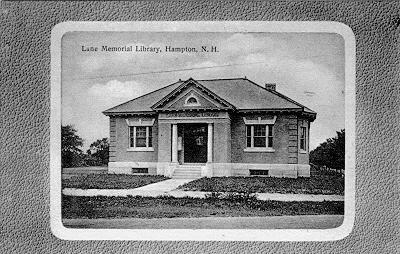
Hampton's Lane Memorial Library, circa 1911-1919.
[Courtesy Tuck Museum]
An assistant librarian, name unknown, was hired in 1905, but it was only temporary. How long the position lasted is not known to this writer.
In time the need for more space became critical and something finally was started in 1908 to remedy the situation. A committee was formed to write a letter to Andrew Carnegie requesting his aid in the erection of a new public library building, and at town meeting the citizens pledged two thousand dollars to the same purpose providing Mr. Carnegie’s reply was favorable.
On the afternoon of April 1, 1908, a meeting was held to review Mr. Carnegie’s reply. He proposed to donate five thousand dollars and require the town to appropriate each year perpetually the sum of five hundred dollars for the support of the library. The town at that time appropriated an annual sum of 250 dollars, yet was not willing to double that figure. Nevertheless, a committee of five was appointed to continue studying the matter of a new library building.
As it turns out, a Hampton citizen stepped forward and offered to build a library as a memorial to his father, Joshua A. Lane, who had just died. This man, Howard Garland Lane, was a wealthy merchant and landowner in town, and held various local offices throughout his lifetime. His wife, Sarah M. Lane, was a library trustee from 1921 until her death in 1944. Howard died July 11, 1957, just a few months before the completion of an addition to the library he presented to the town In 1910.
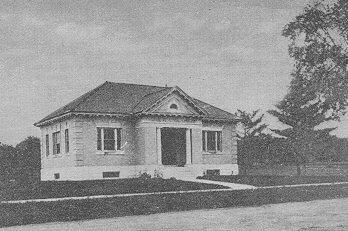
as it looked in the early 1900's
[Courtesy Tuck Museum]
This building, estimated to have cost $15,000, still houses part of the library to this day. It was dedicated in a ceremony held at the Congregational Church on December 14, 1910, and on December 29 the 3,500 books were transferred from the room in the town hall they had occupied for nearly half a century.
The next year the annual appropriation was raised to five hundred dollars, the sum the town was unwilling to provide just three years earlier. The patronage of the Lane family continues to this day however, so it is safe to say that we have benefited more from having a Lane library than from having a Carnegie library.
The stacks in the library had always been closed to the public after 1910, with patrons asking the librarian to retrieve the books they wanted, It was open for this purpose every Wednesday and Saturday afternoon and evening, with the reading room also open every weekday evening. Newspapers and magazines were placed on the tables in the reading room for browsing. A list of these periodicals can be found in the annual town report for many years after 1910. After 1922, the reading room was closed on Tuesday, Thursday, and Friday evenings to save money and fuel.
In 1916, the first trust fund was created for the library. Mrs. A. C. Marie Currier left two thousand to the town “to be used in the construction and fitting of a room in the Public Library . . . to be known as and called the ‘Dearborn Room.'", in memory of her former husband Frederick Dearborn, a native of Hampton.
At the time it was not convenient to add a room onto the library, so the reading room was to be known as the “Dearborn Room” and the two thousand dollars was invested as a trust fund, the interest being added to the annual town appropriation. The room was never built and the trust remains to this day. The naming of the “Dearborn Room” was forgotten over the years. Finally, in 1981, we have officially labeled a room of the library as the “Dearborn Room”, a full 65 years late. A carved wooden sign now hangs over the entrance to our reference room.
In 1919, two bronze tablets were added to the front of the building listing names of men from Hampton in the Civil War and in World War I. A celebration was held In honor of the returned soldiers on Nov. 11, 1919.
In 1929, librarian Shaw remarked that “it is very evident that in the near future the citizens of Hampton will have to consider seriously the problem of providing more room, if the library is to continue to grow and meet the needs of the community.”
After more than 57 years as librarian, Shaw resigned in November of 1931. During that year the library was undergoing a change over from closed stacks to open stacks and a card catalog was being created. About 2,000 books were discarded.
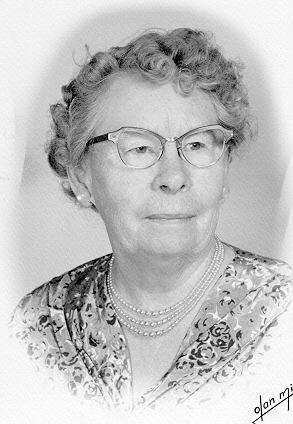
Memorial Librarian from 1931 to 1967.
The above photograph was taken in 1959.
Mrs. Margaret S. Noyes was one of the assistants in these endeavors, and upon Mr. Shaw’s retirement she was hired to fill his position. The circulation jumped as a result of the open stacks from 11,291 in 1930 to 15,331 in 1932, a major leap in those days. Oil heating was introduced In 1933; prior to that date the building was heated by coal. The library remained open Mondays, Wednesdays, and Saturdays for a few hours each day.
The enlargement of the library that S. Albert Shaw saw necessary as early as 1929 finally came about In 1957, when the town voted $40,000 for the construction of an addition and renovations to the old library to be added to a gift of $10,000 from Howard G. Lane and his son, Wheaton J. Lane.
The library was closed during the last four months of the year and the new addition was dedicated on January 5, 1958. The library began opening every weekday from 2:30 to 5:00 and from 7:00 to 9:00 during the school year and only on Mondays, Wednesdays, and Saturdays during the summer.
For several years afterwards, local artists displayed their works on a peg board in the new addition, and the new Friends of the Library group assisted the staff with its maintenance. Eventually this Friends group dissolved until being revived again successfully in October 1968.
In April 1967, the second change in public librarians occurred when Mrs. Charlotte M. Hutton was hired to replace the retiring Margaret Noyes, who had been librarian for over 35 years. In January of that same year, the New Hampshire State Library did a study of the Lane Memorial LIbrary and made several suggestions for bringing Hampton into the 20th century.
Mrs. Hutton, armed with the state’s recommendations, inaugurated several children's programs, including the Magic Green Carpet story hour and summer reading programs. Films and stories were used to entertain the children. The old card catalog was completely scrapped and a new one begun with the help of volunteers, particularly Mrs. Arlene Farrell who is still typing the library's catalog cards on her own time.
The town budget committee also heeded the state’s advice and raised the appropriation from $9,000 in 1966 to $14,500 in 1967. The newly formed Friends of the Library group donated many hours of volunteer help in addition to buying furniture and other supplies for the library. Recordings, pamphlets, large print books, and a statewide borrowers card were just some of the current services added at that time. Eventually, circulating art, art prints, games, puzzles, and paperbacks were available for loan. A photocopying machine was installed in 1972.
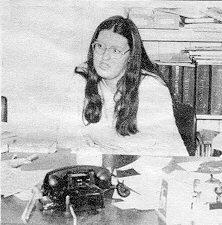
Librarian for Hampton's Lane Memorial Library.
Kathleen was photographed hard at work last
Monday, March 23, 1981.
Another major accomplishment of the late 60’s and early 70’s was the organizing of several area libraries in book, film, and art purchasing cooperatives, gaining for the libraries involved discounts of up to 40% on books and the best discounts available on films and art. Various libraries have joined or left these cooperatives, but Hampton has been involved in each one since their beginnings.
in 1975, another study report was done on the Lane Memorial Library, this time by library staff and volunteers from the Friends. It recommended programs and changes to be implemented over the next five years, the most important of which was to be the building of a major addition to the library.
The plans were to remove the 1957 addition and add on a modern three-story structure in its place, still attached to the old 1910 structure. Wheaton J. Lane donated $25,000 towards the plan and in 1977 an article was placed on the town warrant for $500,000 to build the planned addition. This failed, as did another attempt for $960,735 the next year.
After a one-year break, another request was made on the 1980 warrant for $985,000, a sum that represented only the construction of the basic building. The money for the interior design and furniture would be raised through donations. Again, however, the people voted down the proposal.
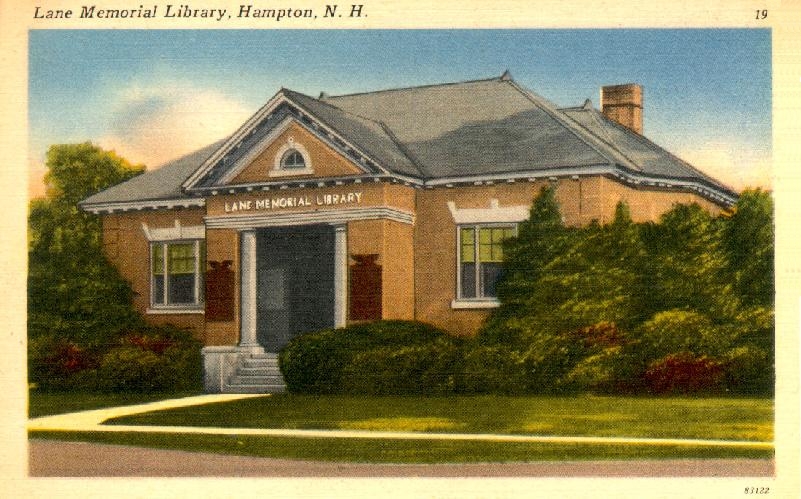
In 1981, the trustees, librarian, and building committee took a different approach by asking for only $100,000 to be used as a Capital Reserve Fund for library expansion. This article passed by a large majority. Now we will raise as much money as possible through foundation, corporation, business, and individual grants and donations and come back to town meeting for the remainder of the sum in one or two years. We are examining the possibility of building an entirely new building on a different site, rather than add an addition to the old building.
The third change in librarians in 100 years came in February 1980 when William H. Teschek, then the assistant librarian, became librarian in place of Mrs. Hutton who remains with the library in the capacity of Director of Cooperative Services. She now directs the very cooperatives that she had set up during her term as librarian.
The library has had an assistant librarian since 1949, but the name or names of the early ones are not known. Those we do know of follow: Mrs. Sadie Arnold, left in 1959; Mrs. Lucy Hadley, 1959-1971; Mrs. Lucy Bume, 1971-1974; Mrs. Audrey Ross, 1974-1979; WIlliam H. Teschek, 1979-1980; Kathleen L. Dunbrack, 1980 --.
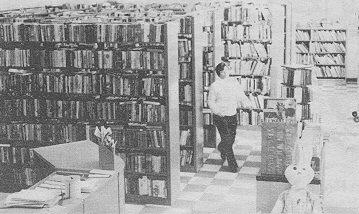
The interior of the Lane Memorial Library addition. The copper time capsule is at right, next to left side of bunny. Jean Ewing, Library Assistant, is pictured in center returning books to the crowded shelves. Jean has been at the library for four years.
